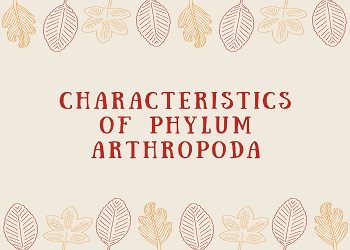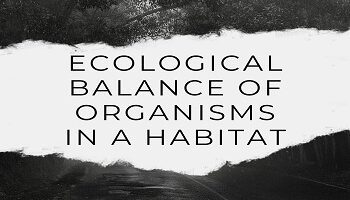Table of Contents
Characteristics of Phylum Arthropoda:
- Arthropods are triploblastic, bilaterally symmetrical, segmented eucoelomates, but the segments are not separated by septa internally.
- The body is externally segmented. The segments are further grouped to form two to three regions called head, thorax and abdomen. The head may be fused with the thorax to form a cephalothorax.
- Arthropods exhibit a high degree of cephalization. The Head is formed by the fusion of a few anterior segments (usually 5) and an anterior non-segmented prostomium. The Head carries sense organs (eye, antennae) and mouthparts. Eyes are generally compound having a number of similar units called ommatidia.
- Arthropods have jointed appendages. The appendages are paired i.e. two per segment. They are modified to form jaws, antennae, palps, legs etc. Antenna are absent in Arachnida.
- These have a sclerotized exoskeleton which is formed of chitinous cuticular plates called sclerites. Exoskeleton undergoes periodic moulting or ecdysis. The exoskeleton of most crustaceans are biomineralized with calcium carbonate extracted from the water.
- Body Wall consists of a non-cellular cuticle, a cellular epidermis, a dermis of loose connective tissue and striated muscles arranged in segmental sheets or bundles.
- The alimentary canal is complete and coiled.
- These are the first animals to have voluntary muscles.
- Respiration occurs by gills, book gills, trachea (insects) and book lungs (scorpions).
- The circulatory system is open-type with a dorsal tubular heart.
- The excretory system is well developed. It is commonly green gland or malpighian tubules. Excretory product is ammonia and urea in aquatic forms and uric acid in terrestrial forms.
- The nervous system consists of a nerve ring and a double ventral nerve cord with ganglia.
- Sense organs are well developed and are
- Antennae or Feelers– tactile (perceive a sense of touch).
- Eyes photoreceptors (perceive light).
- Statocysts– organs of balance.
- Taste receptors located in insect feet.
- Sound receptors in Crickets and Cicada.
- An endocrine system consisting of prothoracic glands, corpora cardiaca and corpora allata is present. These secrete ecdysone and prothoracicotropic hormones respectively. Insects communicate through pheromones. Some pheromones act as sex attractants.
- Sexes are generally unisexual or dioecious. Fertilization may be external (in aquatic forms example- prawn) but is mostly internal. These are generally oviparous while only a few are viviparous (example- Scorpion). Development may be direct (Cockroach) or indirect (example- caterpillar larva in butterflies and moths).
Phylum Arthropoda Examples:
| Prawn | Periplaneta (Cockroach) | Cancer (Common Crab) |
| Charaxes (Butterfly) | Musca (House Fly) | Balanus (Barnacle) |
| Buthus (Scorpion) | Millipede | Limulus (King Crab) |
| Ant | Scolopendra (Centipede) | Anopheles (Mosquito) |
| Araneus (Garden Spiser) | Lepisma (Silver Fish) | Anax (Dragonfly) |
Advancement Over Annelida:
- Perfect cephalization.
- Development of exoskeleton for protection and muscle attachment.
- Occurrence of paired jointed appendages for different functions.
- Higher development of sensory organs like eyes, auditory organs, statocyst.
- An improved excretory system with malpighian tubules and green glands.
- Special respiratory organs like tracheal, book lungs, gills etc.
- Occurrence of endocrine glands.
- Striated muscles arranged in segmental bundles.
- Absence of cilia.
Phylum Arthropoda considered as the largest group of Animal Kingdom because:
- Animals of this kingdom are versatile and found distributed in all types of habitat- aquatic (freshwater or marine), terrestrial and aerial.
- They feed on plants and animals in various ways and their mouthparts are highly specialized and modified for various types of food. They may be cannabolic, carnivores or omnivores.
- They possess jointed appendages.
- Respiration may occur by gills, trachea, book lungs.
- The circulation system is of open type.
- They may be social, pathogenic or free living.









Comments (No)